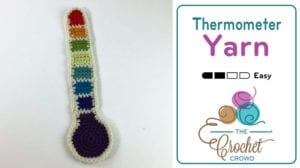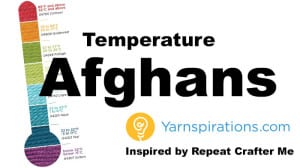
Crochet Yarn Thermometer
The Yarn Thermometer is complimentary to your Temperature Afghan. You can apply this thermometer to your project when complete so people have an idea of what the colours mean. The colours used in the thermometer are subjective to whatever you decide is appropriate.
For us here in the North, our temperatures can range from - 20 to over 40 degrees in the summer. We have a wide range of temperatures. If you live in a warmer climate, you may have different increments so you have a variety of colours.
Pattern Suggestions
- Crochet Teen / Adult Bun Hat + Tutorial
- Super Soft Crochet Baby Blanket Pattern
- Crochet Woven Pillow Pattern + Tutorial
- Crochet Baby Blanket Star + Tutorial
- Crochet Baskets/Flower Cozies + Tutorial

For information on how to create your own Temperature Afghan. Also included is a free program to check the temperatures from the past. Find it here at the Temperature Afghan.
For example, if you don't get temperatures as cool or as hot as the thermometer, change the denomination of the gauge where the bottom is the maximum lowest in your community. To have a variety of colours, you can change the temperature range for 1 colour. For example, if you are living in Arizona, Red is 120 degrees, Yellow is 110, Green is 100 and so on.
- Red = Over 90 degrees
- Yellow = 78 - 89 degrees
- Green = 67 - 77 degrees
- Light Green = 54 - 66 degrees
- Light Blue = 44 - 53 degrees
- Aqua = 33 to 43 degrees
- Blue = 23 - 32 degrees
- Purple = Below 22 degrees
The size of this thermometer is approximately 13" x 3". Use the same yarn and hook for the project to make your thermometer.
Instructions
Use as many colours as you feel you want in your Temperature Afghans or projects. Using the coldest colour, start with the ball area of the base of the thermometer.
- (RS) Using the coldest colour. Ch 2, 6 sc second ch from hook. Join with sl st to first sc.
- Ch 1, 2 sc in each st around. Join with sl st to beg sc.
- Ch 1, *1 sc, 2 sc in next. Repeat * around. Join with sl st to beg sc.
- Ch 1, *1 sc in next 2 sts, 2 sc in next. Repeat * around. Join with sl st to beg sc.
- Ch 1, *1 sc in next 3 sts, 2 sc in next. Repeat * around. Join with sl st to beg sc.
- Ch 1, 1 sc in next 5 sts. Turn.
- Ch 1, 1 sc in each across. Fasten off colour.
Separation Colour - Cream / White (subjective to your creativity)
- Attach separation colour, ch 1, 1 sc in each across. Fasten off.
With the next colours all the way to the colour before the top colour. Do as follows.
- Attach the next colour. Ch 1, 1 sc in each across. Turn.
- Ch 1, 1 sc in each across. Turn.
- Ch 1, 1 sc in each across. Fasten off. Turn.
Repeat by doing the separation colour and then continue with the next colour as indicated above.
Final Top Section
- Apply 1 row of the separation colour. Fasten off.
- Attach the next colour. Ch 1, 1 sc in each across. Turn.
- Ch 1, 1 sc in each across. Turn.
- Ch 1, 1 sc in each across. Fasten off. Turn.
- 7 dc in 3rd stitch across. Sl st in final stitch. Fasten off.
Outline
The outline provides a nice border to help separate the colours and make it stand out on your project. Use the same colour as you did the separation colour. In my case, I did cream.
- On (RS). Fasten on at the ball section of the thermometer. Apply 1 sc in each st or side of row as you work around your project. No additional extra stitches are required on the ball or top area.
- Join with sl st to beginning sc.
- Fasten off, weave in ends.
Sew onto your project when your project is done.

Sylvie Garand says
Where can i find a website to get our weather for my kids birth year?
Mikey says
It used to exist but the website was free. I think the programmer couldn't afford to keep it free and was taken offline. I don't know of any at this time.
Michelle King says
You can go to this website and enter in the city and state, as well as, the specific day of each month for whatever year you want.
https://www.wunderground.com/history
Linden says
wunderground.com has historical weather data! I like to print out monthly records and use that as my pattern for temperature blankets.
Linden says
wunderground.com has historical weather data for free!
K says
Thank you for this tutorial. I’m doing 3 different areas of the USA and wide temperature ranges. This will be perfect!